Article
Martin Luther II: Erfurt the City, Luther the Monk
Author(s):
The City of Towers, where Martin Luther was a monk, is worth a longer visit beyond celebrating 500 years of the man who began the Reformation.
Photography by the authors
Erfurt is the capital of Thuringia. That calls for a pause.
No, Thuringia is not one of those tiny Mickey Mouse kingdoms scattered across Europe whose monarchs raid Hollywood for their queens. Thuringia is big, one of the 16 federal states of Germany, and Americans are forgiven if they do not know that or that Erfurt, a city of 200,000 population, is its capital.
They are forgiven —
even though the city goes back in history to the year 742 —
because the hodgepodge that calls itself European history is almost completely beyond the comprehension of any outsider. German history, itself, is not an easy read: brilliant tactician Frederick the Great, who came to power in 1740, unified all the small territories to create Germany. Napoleon, in breaking up the German Empire after his great victories in 1806, remarked he couldn’t have succeeded had Frederick the Great still been alive to confront him in battle.
So here’s Thuringia in central Germany waiting to enchant any American visitors who come on a voyage of discovery. And here’s our guide, Matthias, anxious to show us the magnificent Merchants’ Bridge that has cellars below it and shops and houses above it. And to point out the Municipal Museum (bottom left), a late Renaissance building whose original owner made his fortune in fish: the almighty cod. And a hundred yards farther on, the Printing Museum in a 19th century storehouse (bottom right).

If visitors come during the Luther Country 500 Years’ celebration that continues until 2017, they will find much that connects Erfurt to the father of the Reformation. Here is where Martin Luther went to university at the age of 17 in 1501 and, four years later, entered a monastery to become a novice monk. Erfurt determined his decisive years.
Before we go off in search of Luther we need to talk about this city, because most of the other places that commemorate Luther are small towns and there’s not much of interest once you’ve explored the Luther connection —
but in Erfurt there’s a lot to discover to justify a longer visit.
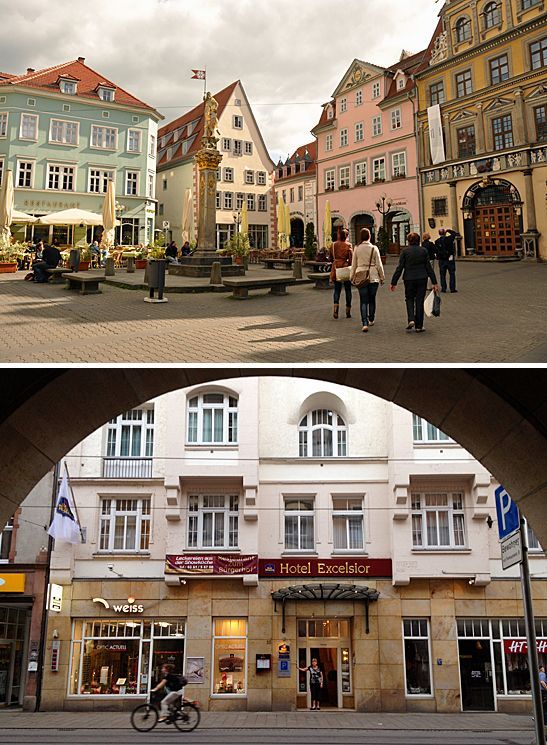
Erfurt has, naturally, the half-timbered, colorful houses with archways and overhanging roofs that are found in any German town with a medieval history. It has great, little, relatively inexpensive hotels like the Hotel Excelsior, so close to the railway station you won’t need a taxi even with luggage.
Erfurt has excellent public transportation for moving around the city and beyond —
Weimar, for example, with its Goethe and Schiller connections, lies only 13 minutes away on the VMT service; and Jena, the site of Napoleon’s 1806 victory is reached in 30 minutes. And Tram no. 4 will take you to the airport in 20 minutes, but you won’t want to leave.
Because, to begin with, there are more than a dozen really interesting museums.
“Surprised?” asks a German fellow guest at our hotel breakfast seeing us with our maps. “Ha! You thought you wouldn’t find anything intellectual here! You thought it would be just oom-pah music, lederhosen and beer gardens, right? That’s silly old Bavaria! We are much more classy. We are the Thuringian Rome. And we have our own style of cooking in Thuringia. We make our own special dumplings from potatoes with lots of meat. Great cooks, great tastes. We actually stage the Olympic Games of Cooking every four years, next one this October!”
Turns out he’s actually telling the truth. We’d never heard of it but there is an International Culinary Olympics in Erfurt every four years, and at the last one in 2008, 140 teams from all over the world and 2,000 chefs competed here in town. It apparently all started in Frankfurt in 1896.
But the Luther story here starts a lot earlier —
in 1501
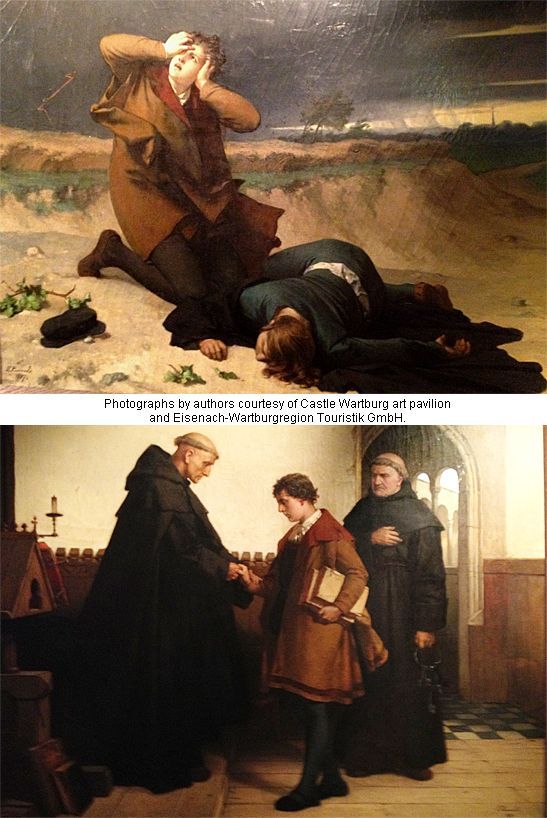
The events are shown in the paintings in Castle Wartburg near Eisenbach. There may have been artistic liberties. In one account Luther was returning from visiting his parents when a violent thunderstorm crashed around him. In another version Luther was walking with a friend who was killed in the lightning strike. Terrified he fell to the ground and cried out to Saint Anna for help. If God would save him, he would become a monk. He survived and entered the Augustinian monastery in town 15 days later.

The monastery still exists though it was damaged in an air-raid in World War II. The cell Luther occupied is open to the public, and his personal Bibles —
complete with his handwritten notes in the margins —
are on display.
this is not the real meaning, better to have said it this way…
A guide translates one remark for us: “…” says his notation, suggesting, even then, he was comparing the Latin Bible with Greek and Hebrew versions from which latter versions he would one day translate the New Testament into vernacular German.

Our guide, Matthias Gose, and the curator show us to the library and the church interior. The tombstones go back to 1298. The gravestone directly in front of the altar marks where Johannes Zachariae is buried. We read his name in dismay. When Jan Hus, the priest and rector of Prague University came to the Council of Constance in 1415 with a safe conduct from the Church (necessary as he was fighting the pope over the sale of “indulgencies” —
where if you pay enough you get into heaven) his safe passage was dishonored by Zachariae allowing Hus to be burned at the stake.

When Luther took his final vows as a monk in 1506, he had to prostrate himself on this tombstone. He could not have foreseen that a century after Hus he might be similarly at risk for protesting how sinners could have their sins and those of their ancestors resolved —
not by penitence and confession, but by buying “indulgencies.”
The curator tells us that when young Joseph Fiennes played the role of Marin Luther in the movie he declined to lie on Zachariae’s tombstone for the movie shot.
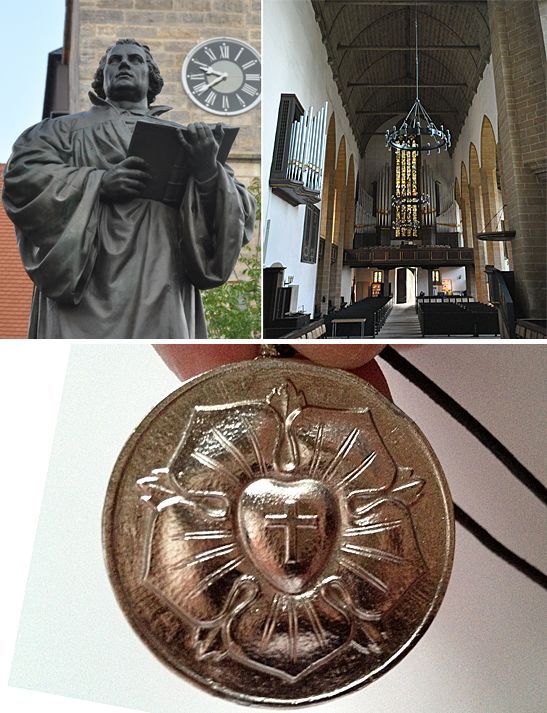
The interior of the monastery is rather stark, but it is now a secular building and in fact visitors to Erfurt can request overnight stays here as if it were a hostel or hotel. In Erfurt’s Luther statue he is shown as the young man he was then.
here
here
here
“We are the city of the young Martin Luther,” says Matthias. “Here he was a Catholic! He was a monk , got his PhD , and his writings were published . I find this younger part of his life easier to understand, because I’m only 33 years old.”
Matthias agrees Luther was a complicated person.
“He wanted a God who was a strong father, a fair judge but a person who could be loved,” he says.
Books about Luther in the monastery state that Luther was an over-zealous novice and “fasted in self-imposed asceticism for days … and often confessed for several hours.” His father confessor called the confessions “hard work and trivial sins…” and once said to Luther, “You are a fool, God is not angry with you, but you are angry with God.”
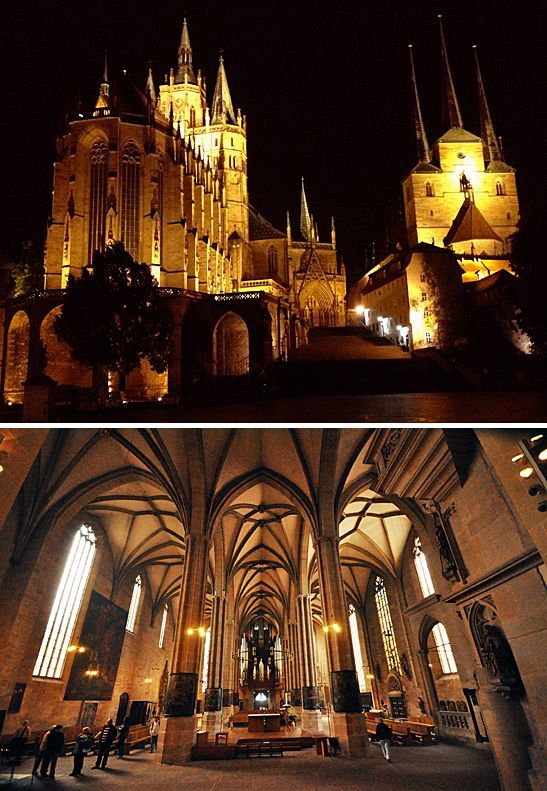
Luther was ordained a priest in Erfurt cathedral and celebrated his first Mass there. He was sent to Rome (records say on foot, 1,000 miles distant), on church business but the corruption he saw there horrified him. His doubts increased, but then he was transferred to Wittenberg where he would live for the next 35 years.
Kramerbruke
Other places catch your attention in Erfurt. This “City of Towers” with its 142 bridges over the river Gera, and its city tributaries has one bridge in particular that brings visitors from all over Europe, its , the Merchants’ Bridge, first described in 1117. The wooden bridge repeatedly burned down and was replaced with a stone one in 1325. It is the longest bridge in Europe with inhabited houses on its full span of 410 feet.
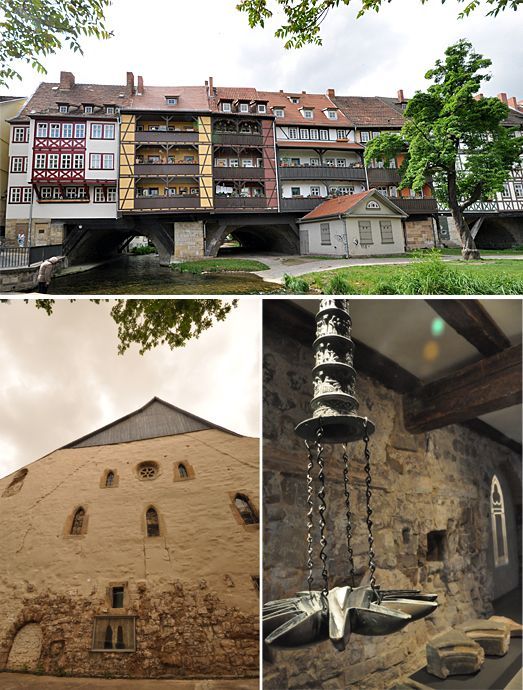
pogrom
Another building of great historical significance is the Old Jewish Synagogue. It was built about the year 1100 and improved over the next two centuries. After the of 1349 the building was converted into a store house. Other buildings encroached on the synagogue, hiding its lancet windows and tracery rosette and allowing its identity to be obscured. It became a dance hall about 1876 all the way though the time when the Nazi party had soldiers here in the 1930s. Such sacrilege is forgiven because it permitted the building to survive unrecognized and later to be excavated and restored.
The basement exhibits “The Erfurt Treasure”: 66 pounds of silver coins and bars and more than 700 examples of goldsmith workmanship. It was discovered in 1998 when the Jewish Quarter was being excavated. The most important item is a gorgeous early 14th century gold Jewish wedding ring. The treasure also includes 14 pancake-size silver ingots from the end of the 13th century stamped with the name Johannis Nase of Mainz.
“Those were yesterday’s Euros!” Matthias murmurs in our ears. “They were used for trading across regions as far away as 20 kilometers.”
We are now going farther afield than 20 kilometers. We’re checking out of our Hotel Excelsior, bouncing our luggage over the cobbles for three minutes and boarding our train to Wittenberg 130 miles away. We are leaving behind Luther’s Erfurt of September 1511 and will be sharing his torment until October of 1517 when he strode up the main street to the wooden door of Wittenberg’s Castle Church, with hammer and nails and history in his hands.
Part 1 | Part 3 | Part 4 (coming 8/9/12!)
The Man Who Cried Orange: Stories from a Doctor's Life.
The Andersons, who live in San Diego, are the resident travel & cruise columnists for Physician's Money Digest. Nancy is a former nursing educator, Eric a retired MD. The one-time president of the NH Academy of Family Practice, Eric is the only physician in the Society of American Travel Writers. He has also written five books, the last called




